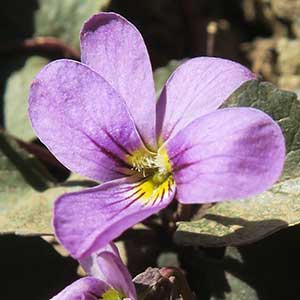Viola flettii
Viola affinis
Flett's violet, Olympic violet, rock violet
Le Conte's violet, sand violet, violette affine
1–3, ascending to erect, mostly glabrous, on caudex from fleshy rhizome.
basal and cauline;
basal: 1–3;
stipules linear-lanceolate, margins entire or with glandular processes, apex acuminate;
petiole 1.5–9.7 cm, mostly glabrous;
blade purple-tinted and –veined, broadly reniform to ovate, 0.9–2.4 × 1.2–4 cm, base cordate, margins finely crenate-serrate, eciliate, apex acute to obtuse, surfaces glabrous or sparsely pubescent along veins adaxially;
cauline similar to basal except: stipules ovate to lanceolate, margins entire or shallowly laciniate;
petiole 0.7–5.9 cm, usually glabrous;
blade 0.8–2.1 × 1.2–3.1 cm.
basal, 1–6, ascending to erect;
stipules lanceolate, margins entire or fimbriate, apex acute;
petiole 2–10 cm, glabrous;
blade green abaxially, unlobed, narrowly to broadly ovate or narrowly deltate, 1.5–10 × 1.5–10 cm, not fleshy, base cordate to broadly cordate or almost truncate, margins crenate to serrate, ciliate or eciliate, apex acute to obtuse, surfaces sparsely pubescent adaxially, rarely glabrous.
1.8–7.1 cm, usually glabrous.
3–15 cm, glabrous or pubescent.
sepals lanceolate, margins eciliate, auricles 0.5–1.5 mm;
petals soft reddish violet on both surfaces, all with yellow area basally, lower 3 dark violet-veined, lateral 2 bearded, lowest with white around yellow area, 10–15 mm, spur yellow, gibbous, 0.5–2 mm;
style head bearded; cleistogamous flowers axillary.
sepals lanceolate to ovate, margins ciliate or eciliate, auricles 1–2 mm;
petals lavender-violet to dull reddish violet on both surfaces, lower 3 white basally and darker violet-veined, lateral 2 bearded, lowest 10–22 mm, usually obviously bearded, rarely beardless, spur white or same color as petals, gibbous, 2–3 mm;
style head beardless; cleistogamous flowers from prostrate to ascending peduncles.
± spherical, 5–9 mm, glabrous.
often reddish or purplish-flecked or green, ellipsoid, 5–10 mm, glabrous or puberulent.
dark brown to brownish purple, 2.5–3 mm.
beige, mottled to bronze, 1.5–2.5 mm.
= 54.
Viola flettii
Viola affinis
Viola flettii is endemic to the Olympic Mountains of northwestern Washington. C. S. McCreary (2005) noted that although morphologically and ecologically distinct, V. cuneata, V. flettii, and V. ocellata are closely related.
(Discussion copyrighted by Flora of North America; reprinted with permission.)
L. E. McKinney (1992) considered Viola affinis, and much of what botanists had called V. nephrophylla, to be essentially the same taxon. After studying additional specimens, reviewing literature (H. E. Ballard 1994; A. Haines 2001b), and discussions with others (J. Cayouette, H. E. Ballard, A. Haines, pers. comm.), he chose to maintain these as separate taxa. Reports of V. affinis in the Gulf coastal states based on specimens or photographs are usually attributable to V. missouriensis.
Viola affinis reportedly hybridizes with V. hirsutula (= V. ×consobrina House), V. cucullata (= V. ×consocia House), V. brittoniana (= V. ×davisii House), V. sororia (= V. ×filicetorum Greene [as species]), V. sagittata var. sagittata (= V. ×hollickii House), and V. nephrophylla (= V. ×subaffinis House).
(Discussion copyrighted by Flora of North America; reprinted with permission.)


